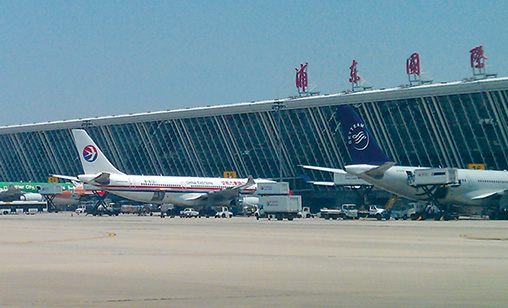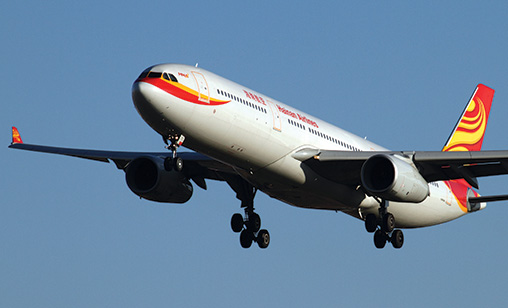Special Report
Bilateral barriers
The rapid growth of Chinese airlines on intercontinental routes is almost as impressive as the expansion of the the Gulf carriers. But do Mainland airlines, with their huge fleets, have the freedom they want to expand worldwide? Chief correspondent, Tom Ballantyne, examines the issues that curb the global ambitions of China’s carriers.
April 1st 2016
At the latest count, China’s four largest airlines - Air China, China Southern, China Eastern and Hainan - had a combined fleet of 1,440 passenger jets and another 457 aircraft on order. Read More » Not surprisingly, given the rapid growth in domestic and short-haul regional traffic, the majority of them are single-aisle A320s and B737s.
 |
But the Mainland carriers also are operating more than 230 wide bodies, ranging from the A330 and the A380 to the B777, B787 and B747, and have more than one hundred large aircraft on order, including the A350.
As these long haul jets come on line Chinese carriers will look for destinations for the aircraft to service either by new routes or frequency enhancement.
But congested airports mean slot constraints and, with many of China’s bilateral air service agreements already closing in on their limits, negotiations to extend and expand air rights agreements are complicated and lengthy.
From July 2013 to July 2015, flight capacity between China and North America increased by around 60%, according to consultants CAPA and figures from OAG. By 2034, the International Air Transport Association (IATA) estimated one in five passengers worldwide will be traveling to, from or within China, a prospect that is making Chinese and non-Chinese carriers alike excited. However, there are serious doubts that Chinese carriers will be able to take full advantage of expanding traveler demand.
One market in particular, the U.S., is critical of Chinese airlines’ offshore market penetration. So far, despite months of negotiations, there is no indication that China-U.S. open skies, or even an expansion of the existing bilateral, are on the horizon.
Under the existing agreement, dating back almost a decade, Chinese passenger airlines are limited to 180 round-trip flights per week between the two countries. U.S. passenger carriers are allotted 160 weekly round-trip flights between the U.S. and three of China’s mega cities.
According to aviation data and analytics company OAG, in 2015 the top four Chinese airlines averaged 148 round-trip flights per week while their U.S. rivals hit 128 weekly round-trips.
With growth in passenger traffic between China and North America booming, and forecast to continue to expand every year, it is developing into a major challenge for airlines. Chinese airlines now operate more flights across the Pacific than their U.S. counterparts and want to grow. Their ambitions will be stymied if the politics involved in negotiations are not addressed.
Exploratory talks aimed at easing flight restrictions began in Washington in May last year. By August, they came to an abrupt halt after U.S. officials refused to pursue formal negotiations unless Beijing presented plans to reform what the U.S. called “an opaque allocation system”. The U.S. negotiators claimed this system gave Mainland state-owned airlines better time slots than the U.S. carriers. China said the U.S. is “dragging its feet” and Washington said “the ball is in China’s court”.
How concerned are Chinese airlines about the situation? While most airlines will not comment publicly on the issue, one senior executive spoke out at an industry conference last September. Attending the International Aviation Forecast Summit at Squaw Valley in the U.S., Dr. Zhihang Chi, Air China’s vice-president and general manager for North America, presented his company’s growth strategy. He said it started slowly and took nearly 30 years for the carrier to gain a foothold and stabilize it in the U.S. through services to New York, Los Angeles and San Francisco.
 |
But once the company “flipped the switch” things took off in a hurry. The carrier now serves seven North American cities and plans to add two in the coming year. But Dr. Chi said growth would not be as great as the airline wanted it to be.
Air China’s was being “artificially stunted” by the limitations of the current bilateral treaty, he believed, and observed that his airline was “bumping up” against the limits of U.S. rights.
He lamented that the most recent round of negotiations at the governmental level between the U.S. and China had failed to raise the existing flight caps.
Interestingly, while he said it was hard to pin the lack of action on one factor, he suggested the dispute between the big three U.S. airlines and their Middle East counterparts could be contributing to a political climate that made expansion of international air rights into the U.S. hard for domestic politicians to support.
A thirty-year veteran of U.S. aviation, Dr. Chi said there were concerns the treaty would not be amended in the near future. Other Chinese airlines are understood to hold similar views. However, any agreement reached will be a long way from producing open skies between the world’s two largest economies.
When it comes to air service agreements China faces the same issues as many other nations. Airlines may want to expand but governments needed to face the reality of infrastructure constraints to facilitate that expansion.
China’s three major hubs at Beijing, Shanghai and Guangzhou are extremely congested. As well, a new air rights agreement requires concessions on both sides. In China, Beijing has opened more access to many of its secondary cities where populations match major cities in most other countries. There are an increasing number of flights being operated from these cities to international destinations but access to key markets remains restricted.
Nevertheless, both U.S. and Chinese airlines are increasingly taking advantage of access to secondary Chinese cities. Examples include China Eastern Airlines’ 2015 launch of services between Nanjing and Los Angeles, China Southern Airlines’ Wuhan to San Francisco flights and Sichuan Airlines’ Shenyang – Vancouver route.
In 2010, there was an average of one long-haul flight a day to a Chinese secondary city. By the end of last year the number had reached 11.
While it is clear China largely is shying away from a bilateral that might involve full open skies, outside the U.S. it has opened markets for its airlines. In late 2014, it agreed a deal with Britain that allocated more passenger flights from China to the U.K.
| 'In China, Beijing has opened more access to many of its secondary cities where their populations would be major cities in most other countries. There are an increasing number of flights being operated from these cities to international destinations but access to key markets remains restricted' |
The previous agreement, last updated in 2011, limited both countries’ passenger airlines to a maximum of 31 return services per week in each direction to six destinations in each country.
The new agreement increased the weekly maximum to 40 direct flights in each direction. It also allowed more flexibility in allocating destinations served by flights. UK carriers now can serve up to three more Chinese cities than previously permitted.
Early last year, the Mainland signed a new deal with Australia, which also is a big target market for Chinese carriers. It will allow a tripling of services between the countries by the end of this year. There has been debate about the winners in this agreement.
Virgin Australia does not fly to China and Qantas’ only Mainland destination is Shanghai. As a result, Chinese airlines operate more than 90% of the seat capacity between the two countries. But in the end, China’s airlines are happy. So is the Australian government. A Chinese tourism boom is bringing billions of dollars annually into Australia’s domestic economy.
As recently as December, an expanded agreement was announced with Canada. It increased the numbers of cities Canadian and Chinese airlines can serve from 12 to 18 in the other partner’s territory.
These arrangements allow for incremental growth rather than sudden leaps into totally liberalized skies and are expected to be the norm in coming years. For Chinese airlines, eager to place their increasing numbers of new long-haul jets onto new routes, they will undoubtedly put the brakes on some of their expansion.
With the amount of cash Beijing is investing in airport expansion, including its massive new facility at Beijing, it may take several years, but China ultimately will join the open skies club.